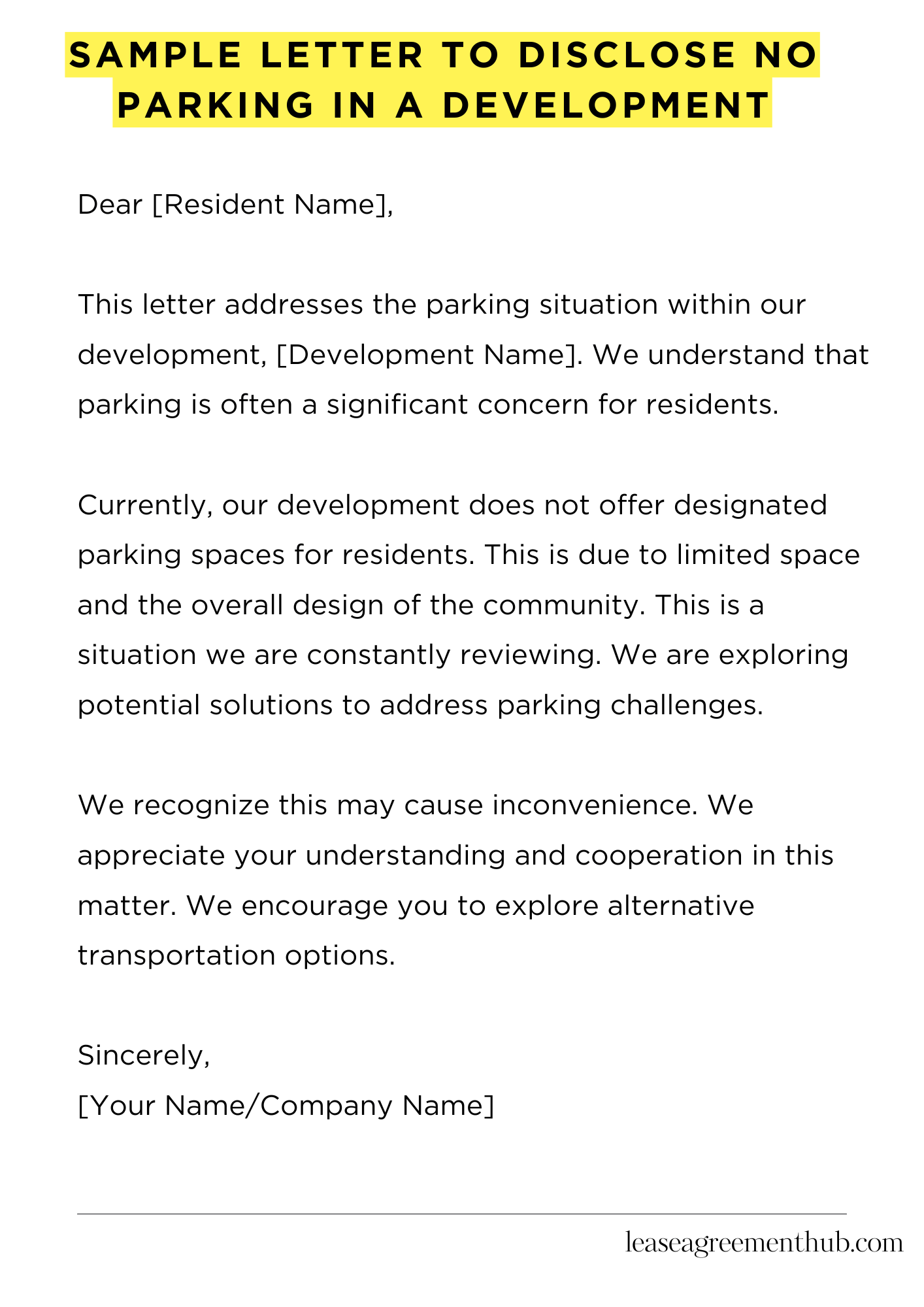A “sample letter to disclose no parking” is a pre-written letter. It’s used to inform residents or tenants about parking limitations. It avoids misunderstandings.
This article gives you examples of these letters. We provide templates. You can use them as a guide.
These samples make writing your own letter easier. They cover different situations. You can adapt them to your needs.
Sample Letter to Disclose No Parking in a Development
[Your Name/Company Name]
[Your Address]
[Your Phone Number]
[Your Email Address]
[Date]
[Resident Name]
[Resident Address]
Dear [Resident Name],
This letter addresses the parking situation within our development, [Development Name]. We understand that parking is often a significant concern for residents. Therefore, we want to clarify our policy regarding parking availability.
Currently, our development does not offer designated parking spaces for residents. This is due to limited space and the overall design of the community. This is a situation we are constantly reviewing. We are exploring potential solutions to address parking challenges. However, there are no immediate solutions available. Future plans will be communicated as they progress.
We recognize this may cause inconvenience. We appreciate your understanding and cooperation in this matter. We encourage you to explore alternative transportation options, such as public transport, cycling, or carpooling where practical.
Please do not hesitate to contact us if you have any questions or concerns. We value your residency here and are committed to creating a positive living environment for everyone. We’ll keep you informed of any changes to our parking policy.
Sincerely,
[Your Name/Company Name]

How to Write a Sample Letter to Disclose No Parking in a Development
Understanding the Nuances of Non-Parking Developments
Many modern developments, particularly in densely populated urban areas, eschew expansive parking provisions. This decision, often driven by environmental concerns and land scarcity, necessitates clear communication with residents and visitors. Failing to do so can lead to significant friction and operational challenges. A well-crafted letter is crucial.
Defining Your Audience and Purpose
Before you even begin composing your missive, ascertain your target audience. Are you addressing prospective buyers, existing residents, or perhaps both? The tone and the level of detail will vary considerably depending on whom you are targeting. A concise and informative approach works best for all audiences.
Crafting a Cogent Salutation and Introduction
Begin with a professional and courteous salutation. Avoid overly familiar or informal language. A simple “Dear Residents” or “Dear Prospective Buyers” suffices. The introduction should succinctly state the letter’s purpose: to clarify the parking situation within the development. Clarity is paramount; ambiguity breeds confusion.
Articulating the Parking Policy with Precision
This section requires meticulous detail. Clearly outline the development’s parking policy. Specify the number of designated parking spaces, if any, and any restrictions on visitor parking. Use precise language, avoiding vague terms like “limited parking.” Consider incorporating specifics like time limits and permitted areas. Remember, obfuscation is the enemy of a well-written communication.
Addressing Potential Concerns and Objections
Proactively address potential concerns. Anticipate questions such as alternative transportation options or the rationale behind the limited parking. Offering solutions or suggestions, such as recommending nearby public transportation or ride-sharing services, demonstrates consideration and mitigates potential negative reactions. This proactive approach is key to fostering good relations.
Concluding with a Call to Action (and Contact Information)
Conclude with a clear call to action. This might be directing residents to a website for more information or providing contact information for any queries. Make this information readily accessible. End with a professional closing such as “Sincerely” or “Regards,” followed by your name and title.
Review and Refinement: The Polishing Stage
Before dissemination, meticulously review your letter for any grammatical errors or inconsistencies. A second pair of eyes is invaluable in catching oversights. Ensure the tone remains consistent throughout and that the information presented is unambiguous and easily digestible. A polished and error-free letter enhances credibility and demonstrates professionalism.
FAQs about sample letter to disclose no parking in a development
Disclosing the lack of parking in a development is crucial for transparency and avoiding future disputes. Crafting a clear and concise letter is key to effective communication.
What information should a “no parking” letter include?
A comprehensive letter should clearly state the absence of parking spaces associated with the development, specify the reasons for this (e.g., limited space, zoning restrictions, environmental considerations), and outline any alternative parking solutions available (e.g., nearby public transportation, recommendations for off-site parking). It’s also important to mention the date and to whom the letter is addressed.
When should this letter be disclosed?
The ideal time to disclose the absence of parking is during the initial stages of the sales or rental process, before potential buyers or tenants commit to the property. This allows them to make informed decisions based on their transportation needs and preferences. Inclusion in marketing materials is also advisable.
What is the legal implication of not disclosing the absence of parking?
Failing to disclose the lack of parking can have serious legal ramifications, potentially leading to lawsuits for misrepresentation or breach of contract. This is especially true if the absence of parking significantly impacts the property’s value or habitability and was not explicitly mentioned.
How formal should the tone of the letter be?
While maintaining a professional and courteous tone is essential, the level of formality depends on the context. A formal, business-like tone is usually appropriate for legal documents or communications with official bodies. For direct communication with potential buyers or tenants, a slightly less formal yet still professional approach can be effective.
What if the development offers limited parking options?
If limited parking is available, the letter should clearly state the number of spaces and allocation process (e.g., first-come, first-served, permit system). It’s crucial to transparently address any limitations and potential waiting lists, allowing prospective buyers or tenants to realistically assess their parking needs.
Related: